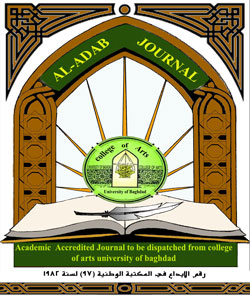The Alternative Homeland: the passive hero in the contemporary Arabic novel
Semiotics study in the active place
DOI:
https://doi.org/10.31973/aj.v0i133.685Keywords:
Semiotics, Text Analyses, Arabic NovelAbstract
Since the Arabic novel was entrusted with the role of the factual record of the struggle of the modern Arab human being, the map of literary fiction has become distributed in new ways, extending beyond the limits of the familiar in formulating thought, feelings and dreams. And because the Arab region is living, in its entirety, a state of changing cultural, value and intellectual constants, topics have emerged in the Arab novel that require a new treatment that attempts to dwell on its most important aspects and the most prominent schemas of its topics, as well as its most present actors.
Hence the semiotic reading of these works, in its cultural form, is an attempt to touch the network of semantics in these works, and to present aspects, such as metaphor, image, and imagination, in a manner different from what was traditionally presented. The narratives selected for the analysis in this article are models that have agreed in aspects of its structure to present the issue of the homeland in a somewhat different way, compatible with the general construction of the supposed reality, not the reality with which they overlap, from time to time.
Downloads
References
- Le Sens pratique, 1980, Minuit, Paris.
- Esquisse d’une théorie de la pratique, 1972, Droz, Paris.
- Geninasca, Jacques : La parole littéraire, 1997, PUF, Paris.
- Panier, Louis : Discours, cohérence, énonciation. Une approche de sémiotique discursive, 2005, Presses de l’Université Paris-Sorbonne, Paris.
- RIFFATERRE, M : La production du texte, Paris, Seuil, 1979, p. 8.
- Eco, Umberto: Semiotics and the Philosophy of Language, 2005, Trns: Ahmad Al-Samaei, Arab Organization for Translation, 1st Edit., Beirut.
- Bomad, Sonya: Kaya, 2014, Al Rewaq Publishing, 1st Edt. Gyze, Egypt.
- Rasool, Ghada Sadeq: The Best Nightmare in the World, 2014, Al-Faraby Publishing, 1st Edit., Beirut.
- Suyuty, Abdulrahman Jalal Eddin al-: Al-Muzher in Sciences and Typologies of Language, N.D, Explained by Ahmad Jad Al-Mawla and others, Dar Al-Turath Publishing, Cairo.
- Shadawi, Ali al-: The Birds of Ethiopia, 2014, Tuwa Media and Publishing, 1st Edit. London.
- Greimas; Algirdas Julien and Fontanille; Jacques, The Semiotics of Passions, 2010, Trans: Saeid Bengrad, Al-Kitab al-Jadeed Publishing, 1st Edit., Beirut.
- Qasem, Afnan: Abdelmajeed Al-Rubayei and the Negative Hero in the Contemporary Arabic Short Story, 1984, Aalam al-Kutub, Beirut.
- Corcuff, Philippe: The New Sociologies between collective and individual, 2013, Trans: Ahmad Haji Safar, Al-Kitab al-Arabi Publishing, Beirut.
- Lotman, Juri: Semiotics of Universe, 2011, Trans: Abdulmajeed Noucy, Arabic Cultural Center Publishing, Beirut.
- Bourdieu, Pierre:
• Practical Reason, 1980, Minuit Publishing, Paris.
• Outline of a Theory of Practice, 1972, Droz Publishing, Paris.
- Geninasca, Jacques: The Literary Speech, 1997, PUF, Paris.
- Panier, Louis: Speech, Coherence, Enunciation. A Discursive Semiotics Approach, 2005, University Paris-Sorbonne Publishing, Paris.
- Riffaterre, M: Text Production, 1979, Seuil Publishing, Paris:
Downloads
Published
Issue
Section
License
Copyright and Licensing:
For all articles published in Al-Adab journal, copyright is retained by the authors. Articles are licensed under an open access Creative Commons CC BY 4.0 license, meaning that anyone may download and read the paper for free. In addition, the article may be reused and quoted provided that the original published version is cited. These conditions allow for maximum use and exposure of the work.
Reproducing Published Material from other Publishers: It is absolutely essential that authors obtain permission to reproduce any published material (figures, schemes, tables or any extract of a text) which does not fall into the public domain, or for which they do not hold the copyright. Permission should be requested by the authors from the copyrightholder (usually the Publisher, please refer to the imprint of the individual publications to identify the copyrightholder).
Permission is required for: Your own works published by other Publishers and for which you did not retain copyright.
Substantial extracts from anyones' works or a series of works.
Use of Tables, Graphs, Charts, Schemes and Artworks if they are unaltered or slightly modified.
Photographs for which you do not hold copyright.
Permission is not required for: Reconstruction of your own table with data already published elsewhere. Please notice that in this case you must cite the source of the data in the form of either "Data from..." or "Adapted from...".
Reasonably short quotes are considered fair use and therefore do not require permission.
Graphs, Charts, Schemes and Artworks that are completely redrawn by the authors and significantly changed beyond recognition do not require permission.
Obtaining Permission
In order to avoid unnecessary delays in the publication process, you should start obtaining permissions as early as possible. If in any doubt about the copyright, apply for permission. Al-Adab Journal cannot publish material from other publications without permission.
The copyright holder may give you instructions on the form of acknowledgement to be followed; otherwise follow the style: "Reproduced with permission from [author], [book/journal title]; published by [publisher], [year].' at the end of the caption of the Table, Figure or Scheme.











